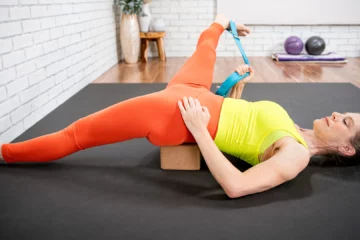
The cue “navel to spine” is used ubiquitously in Pilates and yoga classes. I don’t like it. I don’t use it. It is impossible to sustain, and does not sleeve your spine with the muscular support needed to prevent injury.
Your core involves so much more than just the muscles around your belly button. Your core is comprised of ALL the muscles that circle your spine with support, like a spiral staircase from the tip of your tailbone to the base of your skull. Furthermore, these muscles must work together with ALL of the muscles of respiration! This inner tube has a “tutu” (so to speak) called your diaphragm (the primary muscle of respiration), that attaches to the ribcage in the transverse plane. Therefore, the tensegrity and suppleness of the diaphragm affects the tensegrity and suppleness of the tubular core muscles: they are essentially married to each other, and hopefully in love!
So, how do you activate the totally tubular core with breath? You don’t have to be a valley girl or gag yourself with a spoon to do it, just follow the steps below:
- Inhale and deliberately swell the belly, inflate your ribs, and fill your lungs.
- Hold the breath.
- Pack in all the tissues that you just “poofed” out, as though you have a blood pressure cuff of support around your spine.
- Touch yourself! Palpate the entire surface of your tubular core: belly, sides of the waist, low back, and intercostals (the muscles between your ribs). Underneath the superficial fascia/layer of adipose tissue, it should be FIRM to the touch.
- Exhale.
- Relax the tension and let it all go.
- Repeat steps 1-4, and exhale while still maintaining a sense of the layers of tautness in your tubular core, rather than letting it all go slack. You continue breathing into the full range of the ribs as you maintain the tension in the tissues that brace the spine with support.
By practicing the tubular core exercise, you will gain an embodied understanding of what it feels like to stabilize your spine in a cylindrical fashion: from front to back AND from side to side. And by the way, did you know that you can tubularize your core with the spine in ANY direction of movement? Yes, that includes flexion, extension, rotation, and lateral flexion/extension. The tubular core can be your new best “valley girl” friend in static positions like Warrior poses or during dynamic movement like putting your suitcase in the overhead compartment on the airplane. Try it, and let me know how it goes…
Learn about our stress relief products.
Read more about your diaphragm.











Ive never really thought about how the cue “navel to spine” ignores the rest of the core muscles! But there is so much more to engage than just the navel to spine region. The spiral staircase of musculature that surrounds the spine is a beautiful articulation of our anatomy. Thanks!
Practicing tubular core has been so much more functional as a way to support myself in every day life. It’s also a lot easier to maintain or sustain without creating tension than something like navel to spine.
Today I learned that breathing front to back and from side to side, also has a positive impact on my back!
Navel to spine always felt incomplete and a tension builder. The 360 degree whole torso contraction is so much more effective in turning on ALL the core muscles, and it feels a lot better than just grabbing your navel in.
Trina, Great Tubular core article. I love all your creative words “like a spiral staircase from the tip of your tailbone to the base of your spine”. And the valley girl lingo is right on target for this audience. Very clear instructions.
as someone who has been trying to tame “rib flare” this practice of tubular core breath is just another tool to help with core activation and trunk stabilization.
Man, I spent years pulling ‘navel to spine’ and in my body that often translated to including a tuck of the tail and flattening of the lumbar curve…in other words de-stabilizing the very core I was desperately trying to strengthen! Tubular core has been life-changing and I’m working on refining my descriptions for the benefit of my students.
I love the spiral staircase visualization you offered! Thank you! I’ve also heard it described like an apple core, supported by all the fruit and flesh around it.
Naval to spine is a cue I was taught and which I used for years in teaching. Then I took Yoga Tune Up Teacher Training Level 1 and had an epiphamy when I learned about Tubular Core. Tubular Core addresses the whole core – it literally “pulls it ALL together!” So much more effective! Loved your post!
Navel to the spine is one of those cues that is so ubiquitous, I’m not even sure where I originally picked it up from. I understand it has some value because it is often a cue used to help build awareness of the transverse abdominis, but now that I understand/feel how the core supports all of the spine I can see the extreme limitation of using it. Moreover, I think the term core is often overused as well. For many people core is the same thing as abs and often even after defining what the core is if I say something about the it all I see is a much of taut stomachs!
I’m with you. I hate “belly button to spine!” Good core stabilization requires so many different systems and structures to be in synch. Tubular core is a great and simple approach to cueing proper abdominal stabilization. I’ve been using similar concepts for a long time, although I never called it tubular core! After seeing the YTU approach to teaching and cueing it, it’s just so simple!
Tubular core has change my movement practice! I love this action.
I’m in Jill’s YTU Level One Training now and I’m absolutely amazed at how many gaps YTU fills in from “regular yoga.” Tubular core being one of them. What surprises me most is that I’m been taught to activate all of these muscles separately but not together and I had no idea of their stabilizing effect. Tubular!
Thanks for this explanation. I am taking Todd’s Level 1 YTU and he has a great way of getting us to visualize it as well. This makes sense to me. We had discussion today about Ujayii breathing and it’s place in this or not. We also had discussion that what makes YTU so unique is the multi-disciplinary background of the YTU Teachers. Somehow, YTU has managed to put it all together and I am grateful.
also moved away from the navel to spine cue….sometimes it slips in out of habit but try to cue more top to bottom and front to back 3 dimension-ally.
I was so glad to read this post about the problem with cuing naval to spine. It creates a depression or fold around the belly button area and doesn’t clearly explain how to engage the tubular core. I like your cues to pack in the tissues and to use your hands to feel for proper engagement.
*this may show up twice
1.) I’m curious how this would effect someone with a hypertonic pelvic floor. Wouldn’t all this additional contracting be a problem?
2.) Would this be advisable for someone with incontinence? As in “locking and loading” like that before exertion?
Thanks! cathy
I love this article with my whole heart! As a dancer/choreographer as well as a yoga and fitness instructor, I couldn’t agree with you more! I see too many navel to spine cues not only NOT successfully engaging the core in a tubular way but more often, that cue simply creates more alignment issues. Tubular core is simply the way to go!
le corset tibulaire!!! ca a changé mon enseignement du pilates !!!! Pour le mieux
Tubular core has completely changed the sensation of abdominal work for me. Navel to spine has never made sense in my body. Today, as we worked on Bicycles in class, my abs felt true work and effort. I’m anxious to more fully integrate tubular core in my daily workout routine. Having birthed three children, I need it! It’s like totally!
I love this exercise. Doing this brought up mild body image issue for me. As an overweight child I used to think I need to suck my stomach in to make it look thinner. As a fit, no longer overweight adult, poofing out my strong core felt weird. “I thought I needed to suck in?” It feels fantastic. The trick now is to remember to use it more often, in yoga poses, throughout the day.
I head the cue “navel to the spine” for the first time the other day and when I tried it I felt like i was being asked to replicate having the wind knocked out of me. The sense of hugging in against fullness is a completely different and more 3D experience. You describe it really well, although I might say a double helix instead of a spiral staircase. Thanks!
I love love your post! I teach Pilates and Yoga, and I have retired the navel to spine cue, it is so local! I have also started using the tubular core cues that you mention and that we learned in our YTY training. At first I was hesitant simply because I’ve been taught about lateral ribcage breath ONLY. I found that this type of breath was difficult to explain to beginners and to get them to feel it fully, even with the use of their hands or bands. It only targeted one area… But now, with this visual of wrapping a present, or packing in all the tissues that were breathed into my students experienced success right away! And if I can just make my students aware of their breath and of how to engage these essential muscles, I’m having a successful day! Thanks again.
This is very interesting Trina. I’m going to sit with this information. I really like your break down of information. I have also thought navel to spine was not a well rounded cue and I find that clients force their belly in like I punched them or something when I have used it in the past. Which was definitely not what I was going for. I’ve been trying to think of new and creative ways to cue this idea of keeping the abdominals contracted. I’m going to experiment with your verbage on my clients 😉
I am so grateful for the YTU Tubular Core! I am a personal trainer who has been taught to teach the cue you mention -Navel to spine. And I have taught it. But instinctively I knew something was missing. ‘Navel to spine’ cues a core contraction- but what about inhaling after that? And, as you mention, what about the rest of the trunk? The YTU Tubular Core calls forth a beautiful symphony of spinal stabilizers contracting up and down the spine at once, to encourage full trunk activation and spinal support! I have begun using this with all my clients!
I find it interesting the many phrases passed on from teacher to student within yoga, Pilates etc., that don’t explain the true essence of what should be occurring in the body. Many people are unable to understand the “fluff” language used and choose to check out or fake it to make it, which denies them the connection they desperately need with their own bodies. Thank you for your Tune Up of the popular “navel to spine” expression.
I must admit, I’m a “navel to spine” teacher. Thanks for calling me out on it. This week I’ve learned to intricacies of tubular core and struggled with breathing. This post helped me see that I didn’t need to force belly breathing while tubular, which felt confusing and counterintuitive, but rather to send the breath to the ribs.
Tanks for the article on how to hold your core in yoga tune up. It is so very different to the way us yoga teachers have been taught. But as they say ‘, knowledge is power’ and ‘the only thing constant in the world is change’.
Hi Trish:) I have really enjoyed reading your articles! I particularly liked reading about the tubular core cueing as way to help clients understand that the core musculature that supports and surrounds the spine. I like your philosophy of finding your “inner space”:)
Finally, brain and body got it. I can keep tubular core for a moment then I lose it and have to reconnect. Thank you for having us repeat it in class. I have taught it three times today and they understand. it may not have happen overnight but at least the seeds have been planted.
I agree that the term “belly button to the spine” is ubiquitous in yoga classes. And, because of this ubiquitous saying, many people like me have lost touch with their core and the power / strength that comes with it. Changing my habit from pulling my belly button to the spine to tubularizing my core is going to take some practice. But, I hope in time it will become second nature.
During my first 200 TT I injured my lower back very badly. Only through the injury, was I able to understand the importance or even AWARENESS of the core. I have practiced the engagement of the tubular core ever since, although I have yet to define it this way. I must admit that I do use the cue’s navel to spine, but more effectively and closer to the same page of the tubular core, I tend to use “knit your ribs together”. This cue must be used as a reminder throughout class though because it doesn’t sink in fully and now that I think about it, it doesn’t fully translate what we are trying to accomplish with the tubular core. I will now use the imagery of the core as a tube supporting our torso! Thanks!
I’m interested to see how this plays out in the next few weeks, and how this might change the way that I teach and perform “core” work.
I will admit, i’ve always been a “pull the belly button back and up” kind of yoga teacher… not after Yoga Tune Up though! That’s for the great post about the tubular core.
Thank you Trina for the wonderful post. Sleeve your spine is a fabulous visual of really accessing the front, sides and back of the core – not just the front. Very helpful terminology and technique to use when teaching, thank you!
Hi Monica, I am glad you enjoyed this post. I don’t teach seated forward bends because I find that most people have difficulty just sitting on their ischium bones in Dandasana without a posterior pelvic tilt. I prefer to teach hamstring stretches in a supine position so that there isn’t any stress placed of the lumbar vertebra and the stretch can be done with a neutral pelvis (Supta Pada Gustasana/Leg Stretch #1). I hope this is helpful. You will learn all about this on Sunday in the level 1 teacher training.
Thanks Trina. love this post. i never felt supported enough with just drawing navel to spine in standing postures. i would however still use navel to spine on seated forward fold at times …… no good? so you still cue tubular core with this?
There is so much more to it then navel to spine and this technique is great even for the very beginner student.
Love this post Trina – I have been in’core’proating TC into a lot of my daily routines – it is great practice. I like Jill’s cue that you carry your posture into everything so it deserves 90% of your attention.
I recently started teaching a “Pelvic Floor Pilates” class that helps to reeducate people on the health of their pelvic floor and that “do your kegels” just isn’t enough, especially when most people either do them incorrectly or have no clue how to do them at all. The very first class before anything else, I teach people how to breathe. We have been trained through a variety of influences that we have to suck in our gut and most people find belly breathing to be counter intuitive to what their body is used to doing. Once I explain to them how the core muscles work and that the diaphragm and the pelvic floor need to work in sync, it is a bit of an eye opener. I usually get them to exaggerate the belly button to spine and then get them to try to take a big breath in. Volume? Space? Not much. It is a continual internal battle to keep certain muscles locked down until they fatigue and can no longer do their job and to expect the optimal interaction of the rest of the core machine to happen. Now that I also have the language of the Tubular Core, it will only make it an even higher functioning practice. Thanks for your post!
Of course I love the tubular core and I AM a Valley girl. Totally! I enjoyed reading your post and the clear case you present for tubular engagement of all the muscles comprising the core of the body. Thanks, Trina, and I will see you in class. P.S. I will try to keep my ribcage from puffing out–and my core tubular–while making Matador Circles 🙂
I am guilty of overusing this cue. Although it is possible to engage the abdominal muscles without changing the neutral curvature of the spine, it was hard to get students to understand that in each and every class. So I am now officially casting this cue to the side. Tubular core here I come.
Tubular core is a great way to visualize the ENTIRE core and stabilize the spine. I’ve been taught so many different methods but realize now that none of them were protecting my spine all the way around. Thank you for breaking down the pose this way, it is a great tool to refer to.
Hooray Tubular Core! The pieces and parts of this concept have always floated around in my world and I’ve cued (and yes, I’m guilty of “naval to spine”) around in ways to try and achieve what I now understand as Tubular Core…but never in a way that I felt was holistic, all-encompassing, or just plain “right”. I love this tool and am always excited when introducing it to new people- especially those who are then able to achieve other movement patterns because of that supple strength and stability! Hooooooooray Tubular Core!!!! xo
Hi Trina,
As a Power Pilates trained instructor, I am happy to say that we were instructed to never use the cue “navel to spine”. However, I was taught to instruct beginners to focus primarily on their abdominals. The rationale is because the term power house is thought to be too complicated for a beginner to understand. I am currently taking the Yoga Tune Up level 1 Teacher Training at Kripalu and just learned Tubular Core today. It is a relatively easy concept, very effective and I will certainly make it my new “Valley Girl” friend when teaching Pilates from now on.
So spot on. Coming into a sound relationship with your tubular core will not only reap the benefits of improving every one of your yoga asana practices, but also impact your daily life; from sitting in the car, to improved performance in all your athletic activities, to getting your groceries safely to the kitchen…help yourself, come in touch with your tubular core !
I finally got it! Only after practicing the tubular core exercise I was finally able to fully engage the core muscles and preserve a Tadasana spine. So many yoga teachers (I too) instruct to ‘engage the core’ which mostly results in contraction of few of abdominal muscles, compromised spine and absence of breath. Knowing what I’ve learned now from YTU TT I have the tools to, first apply it to my own practice and second, teaching others the proper way to get in touch with their own core.
I am thoroughly embarrassed to admit that I literally used this cue this morning! I love how Yoga Tune Up is changing my thinking skills and language capacity; I feel it’s the one training that has given me the permission to abandon the traditional! It’s no wonder that I always see yoga fairies swimming above my head after any core work – I wasn’t breathing!!
ive been doing pilates for over 15 years and teaching almost 10 and im proud to say i have ALWAYS hated this stupid phrase, even before i knew anything about anything. i makes me think of a person so rail thin and made of nothing that if you stick your finger in their belly button while they are lying flat, you will be able to feel the bottom of the surface theyre laying on, which is thorough ridiculous and kind of means nothing and explains nothing about how the core muscles work! it almost makes them non existent–as if all you have to do is what a 15 year old girl in a bikini does and “suck it in.” so i LOVE the idea of TUBULAR CORE and yay. thanks!
…R.I.P. “navel-to-spine”, so long you’ve shackled my diaphragm. Run free diaphragm!
[…] Tune Up® Blog « Navel To Spine: Are You Hyperventilating Yet? Yoga Tune Up® Will Make You Younger […]
I love the imagery – especially the “tutu” and I learned a new word “tensegrity”. I couldn’t find it in Webster but I get the idea!
Exhaling while holding onto the core or “packing it in” can be so challenging to teach to reverse breathers.
Thanks Trina!
I just finished the final day of YTU Level 1 training and I have to say that one of my favorite take-aways is the tubular core. It’s completely different than the way I’ve been practicing and teaching all these years and it makes SO much sense. It definitely challenges what I thought I knew about breath & core in yoga practice….and in life!
Great post! Activation of our core while breathing deeply seems to be illusive to so many students. The “tubular core” exercise with its cues of an “inflate” followed by “packing in” and “maintaining tautness” are wonderfully clear to help us embody both breath and stabilization of the core in whatever pose we’re in….on or off the mat! Thanks for shedding some light on the subject.
I was enlightened by tubular core in yoga tune up teacher training and not surprised it was taught in the first template, I agree belly to spine is such an isolating move that does not offer full support even when combined with mulabanda. In tubular core fI feel total support in my core, palpating the girdle of muscles contracted such as the rectus abdominus and the obliques gives me confidence that my core is completely engaged.
The tubular core has transformed my understanding of the core. So much stability is created by expanding through the breath and then packing it all in – i just see my spine totally supported and encased all the way around. It feels so much safer and your directions are so clear – it’s much better than “pull the belly in toward the spine.” Thanks for the great language and descriptions
Like many others I had always thought the “core” only included the abdominal muscles. After a back injury it has been stated over & over by my PT, Chiro & MD that this isn’t true. I still need the gentle reminders at time & am loving the tubular core wording because it gives me the visual in my head that once again it’s not just my abdominal muscles.
Your terminology will really resonate with people. Sometimes what seems clear and concise really is just vague. I appreciate your description and your exercise!
I hear navel to spine in most yoga classes that I take. Thanks so much for your clear description of what this actually means!
I practice (as a Rolfer) within a Pilates studio and let me tell you there’s a lot of “navel to spine” floating around out there! Because I get to wander in and out through a variety of privates and mat classes that go on outside my office door (as well as work on some of the Pilates students) I’ve noticed that many people manage to turn the cue “navel to spine” into something that resembles tying twine around their diaphragms, which restricts their breath and pooches out their lower rectus and transverse abdominus, while leaving the obliques totally slack- has anyone else noticed this effect of that cue? In any case, that’s clearly not useful for people or good for bodies, so thanks for this great step by step to a tubularized core!
I love your analogy for the core muscular structure: “like a spiral staircase from the tip of your tailbone to the base of your skull.” I can’t wait to borrow that to help verbally create a more embodied picture for students. Thank you!
This was an “aha!” moment for me. As a yoga student i found it challenging to keep the navel to spine action while breathing. Tubular core makes so much more sense then navel to spine instruction and more accessible for all students. Thanks Trina!
This post really got me thinking… What if, during the big inhale in the belly and up the ribs if you feel something along one side of the neck?
I like this exercise because on the exhale, it really allows the body to release the tension. Even if we don’t think we are holding (or sucking) it in, this exercise allows the body to let it go. After all the work pulling it in and compacting the body tight, the release feels great. And kind of scary to know how very few times in a day I actually allow my body to fully relax. Eek.
I too love the terminology used here, “tubular.” I do think yoga practitioners really need to start thinking of using all the “tubular” muscles/erector muscles of the torso rather than just pulling the navel to the spine. I am definitely a teacher who’s used the phrase, “pull the navel to the spine,” probably in almost every class I’ve ever taught. Why use or strengthen just one area when you can do more. Moreover, for the safety of the spine strengthening all the muscles of the core is essential.
As an Ashtanga practitioner one of the most important elements of the Ashtanga practice is the engagement of the uddiyana bandha throughout the entire practice. I think the phrase “pull the navel to the spine” stems from layman’s terms to engage uddiyana bandha. It’s a pathway for the beginner practitioner to further their practice, however I do think changes to this terminology should be implanted.
Thank you for posting, I love this vision of the tubular core, I have always had trouble with the “Navel to Spine” slogan, and am feeling much more in harmony with the “staircase” method 😉 It’s amazing how restrictive just thinking navel to spine is, so many muscles come together in holding any yoga pose, being dynamic or static. The psoas alone starting at T12 comes all the way around the abdomen and attaches to the anterior hip, this muscle is imperative for stability.
I am currently in YTU training in Boston and we’ve just spent a significant amount of time breaking down the Tubular Core. As a fitness instructor, pilates student and RYT I have been told to “activate my core” in a number of different ways using all kinds of analogies. It wasn’t until this training until I really started to understand and FEEL it in my own body.
Just practiced this for the first time today. What an eye opener! I have to admit that “out of the mouths of babes” this babe included has been the old ‘Navel to Spine” instruction. Brings to mind the Maya Angelou saying I did then what I knew how to do, now that I know better, I do better .Off to practice being “totally tubular!”
Trina This is extremely helpful info and is quite interesting also coming from a pilates back ground myself. But like one of my teachers says in 2-5 years more than half of the info I teach you will be wrong. So practicing non attachment as yogis is probably the best bet. Thanks
The way this is stated really resonates with me and I will definitely be changing my language around this usage rather than “naval to spine.” The fact that this activates and integrates the front and back of the body is not only much more approachable, but anatomically realistic. The way I had previously envisioned it was just armor on the front of the body, whereas this speaks to the internal function. Getting down to the true function rather than what’s fashionable or will look good in Glamour Magazine.
Love your posts 🙂
I’ve been calling this the “funnel” but totally tubular core gets it done too! The funnel’s mouth is the shoulders and our core is the narrowing of the funnel. Getting more “condensed”/”supportive” towards the low belly/pubis bone direction. This compression I explain, is for stability of the spine & pelvis. I really enjoy reading these. Thank you!!!
Sounds good! Try it lying down to…very satisfying.